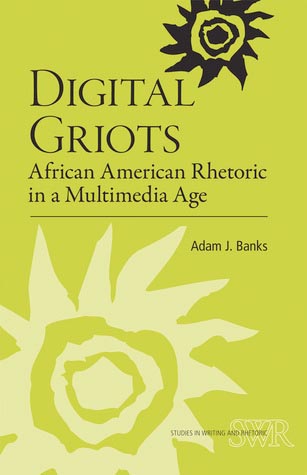Digital Griots: African American Rhetoric in a Multimedia Age
by Adam Banks
Southern Illinois University Press, 2011.
208 pages, ISBN 0809330202
Reviewed by Jessica Edwards
Washington State University
<Introduction> <Groove> <Track 1> <Track 2> <Track 3> <Track 4> <Track 5> <Conclusion> <Works Cited>
Digital Griots: African American Rhetoric in a Multimedia Age
by Adam Banks
Southern Illinois University Press, 2011.
208 pages, ISBN 0809330202
Reviewed by Jessica Edwards
Washington State University
<Introduction> <Groove> <Track 1> <Track 2> <Track 3> <Track 4> <Track 5> <Conclusion> <Works Cited>

Introduction
By bringing in a new flavor to the field of composition, Adam Banks adds depth to the conversation by making connections between oral, print, and digital works via African American rhetoric. Using the Disc Jockey (DJ) as a griotic figure, Banks makes a case for how looking to African American rhetorical traditions can provide transformative access points that will not only provide Black students with an honest, more authentic view of themselves, but will bring a theory to benefit all students who may desire a better understanding of the many cultural influences on multimedia writing and literacy in our society. The DJ, then, works as a storyteller and as a trope that helps readers to see how to connect oral, print, and digital traditions in a culturally responsible way. In the spirit of the griot, who is a storyteller by definition, Banks organizes his book using jargon that is conscientiously captivating and rhythmically relevant to his points about the possibilities of African American rhetorical traditions for Composition Studies. At the end of each chapter, Banks shares a different organization that models connections between storytellers and multimedia outlets; these sections, called shout-outs, work as interludes that add to his argument. Digital Griots: African American Rhetoric in a Multimedia Age models the possibilities of African American rhetoric by using the DJ as a storyteller.